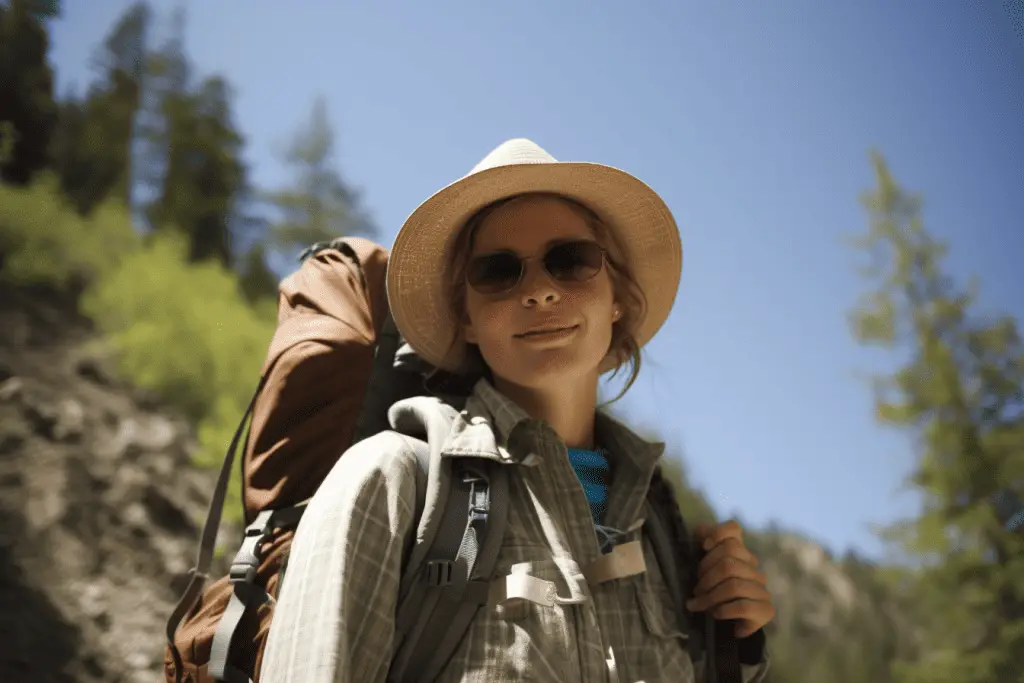Some people believe that hiking is free while others think it costs an arm and a leg. So which is it? How much does hiking cost?
The cost of hiking can vary depending on various factors such as location, duration, and equipment. However, in general, hiking can be a relatively low-cost activity. The main expenses typically include transportation to the hiking location, any necessary permits or fees, and equipment such as hiking boots, backpacks, and camping gear. Additionally, if you plan on staying overnight or eating at restaurants during your hike, there may be additional costs. Overall, hiking can be a budget-friendly outdoor activity.

How Much Does Hiking Cost For Day Hikes
Hiking can be a very affordable activity, but the cost can vary widely based on several factors. So how much does hiking cost when you’re only going for a day hike?
Here are the costs you need to consider:
- Equipment: You’ll need some basic gear, such as good hiking boots, a backpack, water bottles, a first aid kit, a map or compass, and suitable hiking clothing for the climate and terrain. Depending on the quality and brand, basic gear can range from about $100 to $500 or more.
- Food and Water: You may need to invest in trail food and snacks. The cost here can be quite minimal if you bring food from home, or it can add up if you buy specially packaged hiking food.
- Travel: If the trails are not near your home, you may need to account for travel expenses, such as gas, tolls, or public transportation fees. For more remote or famous trails, you might also need to factor in the cost of flights and accommodation.
- Park Fees: Some national parks, state parks, or protected natural areas have entrance fees. These can range from a few dollars to $20-$30 per day. Take a look at the entrance costs on the NPS website. Some parks offer annual passes which can save money if you plan on visiting frequently.
- Guides or Tours: If you’re hiking in unfamiliar territory or tackling challenging terrain, you may want to hire a guide or join a tour. These can vary significantly in price based on the length and difficulty of the hike, but could range from $50 to several hundred dollars.
- Insurance: If you’re hiking in remote areas, especially in other countries, you might need to get travel or emergency evacuation insurance.
Remember, you can often reduce costs by borrowing equipment, carpooling, choosing free trails, and packing your own food. Hiking doesn’t need to be expensive to be enjoyable!
How Much Does It Cost To Go Section Hiking?
A section hike refers to hiking a portion of a longer trail, like the Appalachian Trail or Pacific Crest Trail, over a few days to a few weeks. The cost of a section hike can vary based on several factors. So how much does hiking cost when you go section hiking?
Here are some typical section hiking expenses:
- Gear: If you don’t already have hiking gear, this can be a major cost. For a section hike, you’ll typically need a backpack, tent, sleeping bag, hiking boots, clothing, cooking gear, and navigation tools. If you already own these items, the cost is negligible, but if you’re starting from scratch, you might spend between $500 to $1,500 or more.
- Food and Water: You’ll need to pack food for the duration of your hike. You might spend anywhere from $10 to $20 per day on food, depending on whether you pack your own meals or buy pre-packaged hiking food.
- Travel: You’ll need to account for the cost of traveling to and from the section of the trail you plan to hike. This could include gas, tolls, airfare, car rental, or public transportation.
- Permits and Fees: Some trails require permits, and others have associated park entry fees. These are usually not overly expensive but should be included in your budget.
- Insurance: If you’re hiking in remote areas, particularly in other countries, you might need to account for the cost of travel insurance or emergency evacuation insurance.
So for a section hike, you might expect to spend anywhere from a couple hundred dollars to over a thousand, depending on your specific plans and what gear you already own. As always, there are many ways to reduce these costs, such as borrowing gear, choosing less expensive trails, and packing your own food.

Thru-Hiking Costs: How Much Should I Budget for a Thru-Hike?
A thru-hike, such as the Appalachian Trail, Pacific Crest Trail, or Continental Divide Trail, is a significant investment in terms of both time and money. The exact amount you should budget can vary widely, but there are some common expenses to consider. So how much does hiking cost on a thru-hike?
You can expect to pay for the following things while thru-hiking:
- Gear: High-quality, durable gear is essential for a thru-hike. This includes a backpack, tent, sleeping bag, hiking boots, clothing, cooking gear, and navigation tools. Depending on the quality and brand, expect to spend anywhere from $1,000 to $2,500 or more on gear.
- Food and Water: You’ll need a steady supply of high-calorie food for the duration of your hike. This can be a mix of resupply packages sent ahead to specific locations, meals in towns along the way, and food bought in stores near the trail. Depending on your dietary needs and preferences, you might budget $10 to $20 per day for food, which can add up to $1,500 to $3,000 for a 5-6 month thru-hike.
- Travel: You’ll need to get to the trailhead at the start of the hike and return home from the trail end. Depending on your location and the specific trail, this could include the cost of flights, car rental, gas, or public transportation. You might also need to pay for shuttles or taxis to and from towns for resupply stops.
- Lodging: While most nights will likely be spent camping on the trail, many thru-hikers choose to occasionally stay in hostels, motels, or other accommodations in towns along the route for rest, recovery, and resupply. Depending on the frequency and type of lodging, this could add several hundred dollars to your budget.
- Permits and Fees: Some trails require permits, and others have associated park entry fees. These are usually not excessively expensive, but they should be included in your budget.
- Miscellaneous: This category covers everything from laundry, replacement gear, first aid supplies, personal hygiene items, and other unforeseen costs. It also includes any insurance you may need.
A rough estimate might put the cost of a thru-hike in the range of $4,000 to $8,000, but it could be more or less depending on your specific plans and circumstances. It’s important to remember that thru-hiking is a significant commitment, and it’s better to overestimate your budget to ensure you’re adequately prepared.

Frequently Asked Questions
Is hiking a cheap hobby?
Hiking can be a very affordable hobby, especially compared to many other sports and activities. Here’s why:
No Fees: Many trails and hiking paths are free to access, particularly if they’re local or on public lands.
Basic Equipment: The basic gear required for hiking can be relatively inexpensive. For casual hikes, you’ll need a good pair of shoes or boots, comfortable clothing, a water bottle, and maybe a backpack.
No Training Required: Unlike many sports, you can start hiking without professional lessons or training, which also cuts down on costs.
Low-Cost Nutrition: Food for hiking can be simple and inexpensive, especially if you pack homemade meals and snacks.
However, the cost can increase based on several factors:
Advanced Equipment: If you plan to do more advanced hikes, especially multi-day trips or hikes in difficult weather conditions, you’ll need to invest in higher quality gear. This could include a high-end backpack, hiking poles, GPS devices, specialty clothing, and camping gear.
Travel Costs: If you frequently travel long distances to hike, this can add to the cost of your hobby. Gas, airfare, hotels, and other travel expenses can add up.
Park Fees: While many trails are free, some national or state parks and other protected lands do have entry fees.
Insurance: If you’re hiking in remote areas, particularly in other countries, you may need special travel insurance.
So while hiking can certainly be a cheap hobby, the actual cost can vary greatly depending on how and where you choose to hike. But compared to many other recreational activities, it’s often a very budget-friendly choice.
Why is hiking gear expensive?
Hiking gear can be expensive for a variety of reasons:
Quality and Durability: High-quality hiking gear is designed to withstand tough outdoor conditions and provide a level of performance and durability that cheaper gear might not offer. This includes being waterproof, wind-resistant, temperature-regulating, and tear-resistant. In addition, the materials used in high-end gear are often more expensive.
Research and Development: Companies spend significant amounts on research and development to create gear that’s not only durable but also lightweight, comfortable, and packed with useful features. This can involve advanced technology and innovative materials, all of which contribute to the cost.
Brand Reputation: Some of the cost of hiking gear can be attributed to the brand name. Companies that have established reputations for quality and performance often charge more for their products.
Safety: In some cases, the cost of gear reflects its role in keeping you safe. This is particularly true for items like climbing harnesses, helmets, and certain types of footwear, where failure could have serious consequences.
Sustainability: Some companies are committed to sustainable and ethical manufacturing practices, which can increase production costs. These can include fair labor practices, the use of organic or recycled materials, or carbon-neutral production methods.
While high-quality hiking gear can be an investment, remember that it’s usually designed to last for many years. In many cases, spending more upfront for good gear can be cheaper in the long run than buying cheaper gear that needs to be replaced frequently. Additionally, the comfort, performance, and safety that high-quality gear provides can significantly enhance your hiking experience.
